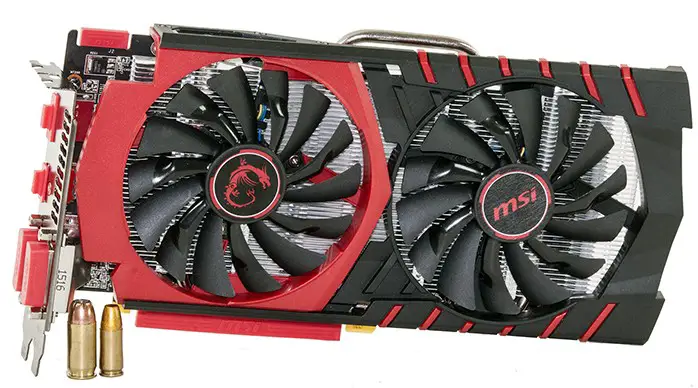Video Card Temperature Results
For all temperature testing the cards were used in an open test bed environment. Ambient temperature was kept at a constant 20°C (+/- 0.5°C) and if the ambient room temperatures rose above 21°C or dropped below 19°C at any time, all benchmarking was stopped until proper temperatures could normalized.
For Idle tests, we let the system idle at the Windows 7 desktop for 25 minutes and recorded the peak temperature.
For Load tests, we ran Unigine’s Valley benchmark for 20 minutes. Considering this GPU core is an overclock, of an overclock…of an overclock these temperatures are blood marvelous. Yes this version of the TF V heatsink is cut down compared to its higher priced siblings but for this core it is more than enough to keep temperatures well in check.
Considering this GPU core is an overclock, of an overclock…of an overclock these temperatures are blood marvelous. Yes this version of the TF V heatsink is cut down compared to its higher priced siblings but for this core it is more than enough to keep temperatures well in check.
Sound Level Test Results
While everyone “hears” noise differently there is one easy way to remove all subjectivness and easily compare different fans: use a sound level meter. This way you can easily compare the various fans noise envelopes without us coloring the results and see what fans fit within your personal comfort level. Of course, we will endeavor to try and explain the various results – which are taken at a 15 inch distance from the GPU’s fan(s) – to help you gain an even better understanding of how loud a cooler’s stock fan is, but even if you discount our personal opinions, the fact remains numbers don’t lie.
For Idle tests, we let the system idle at the Windows 7 desktop for 25 minutes and recorded the peak dB.
For Load tests, we ran Unigine’s Valley benchmark for 20 minutes and recorded the peak dB. This is one area that MSI has down pat, and if you are worried about this hotter running core causing the R7 370 Gaming 2 to be too loud to use…. don’t. It’s a non-issue thanks to Twin FROZR V heatsink and dual fan combination. We truly hope that this silent performance during idle becomes the standard for the industry.
This is one area that MSI has down pat, and if you are worried about this hotter running core causing the R7 370 Gaming 2 to be too loud to use…. don’t. It’s a non-issue thanks to Twin FROZR V heatsink and dual fan combination. We truly hope that this silent performance during idle becomes the standard for the industry.
System Power Consumption
To obtain accurate results we have connected the system to a Power Angle power meter that has in turn been attached to a 1500watt UPS. This ensures only 120volt power is supplied to the PSU and removes an variances that could potential crop up because of brownouts and power spikes.
In order to stress the video card we have once again used Unigine’s Valley benchmark and ran it for 20 minutes to determine peak system power consumption. For idle results we have let the system idle at the Windows 7 desktop for 25 minutes and recorded the peak idle power consumption. As this is a relatively low powered card these results are pretty darn good for what it is. Yes a reference R7 370 will indeed require a couple watts less performance, but in the grand scheme of things this really is not enough of a difference to worry about. The same holds true for this card vs NVIDIA 960 models – as it would take years and years for difference in price to be made up for in lower power consumption. Instead, you will have to justify an R7 370 vs GTX 960 the old fashioned way: and make a decision on how much you can legitimately afford to pay (and justify) for a single video card.
As this is a relatively low powered card these results are pretty darn good for what it is. Yes a reference R7 370 will indeed require a couple watts less performance, but in the grand scheme of things this really is not enough of a difference to worry about. The same holds true for this card vs NVIDIA 960 models – as it would take years and years for difference in price to be made up for in lower power consumption. Instead, you will have to justify an R7 370 vs GTX 960 the old fashioned way: and make a decision on how much you can legitimately afford to pay (and justify) for a single video card.











